| Srl | Item |
| 1 |
ID:
128568
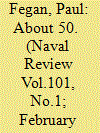

|
|
|
|
|
| Publication |
2013.
|
| Summary/Abstract |
In a series of articles, the author takes a look at cuts, cost and affordability in order to speculate about what could have been and what might be.
|
|
|
|
|
|
|
|
|
|
|
|
|
|
|
|
| 2 |
ID:
085241
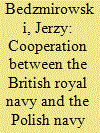

|
|
|
|
|
| Publication |
2008.
|
| Summary/Abstract |
KMW (The Polish Navy Command) - institution is responsible for performance of tasks characteristics of any command of Navy (e.g. Royal Navy Command); in operation in the 1922-1947 period.
|
|
|
|
|
|
|
|
|
|
|
|
|
|
|
|
| 3 |
ID:
144475
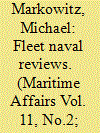

|
|
|
|
|
| Summary/Abstract |
Warships are symbols of national power and pride. Naval reviews are occasions where navies display their fleets in the presence of heads of state, dignitaries and foreign guests. Naval reviews have a long, well-documented history stretching back to the medieval era in Europe. The British Royal Navy has often conducted naval reviews, originally as part of mobilisation for war, later in observance of royal anniversaries and significant occasions. Many navies, influenced by British traditions, have adopted the custom. International naval reviews provide opportunities for officials and military mariners to meet their counterparts, learn about the capabilities of friends and potential adversaries, share experiences and develop relationships that will prove valuable both in times of conflict and in peace.
|
|
|
|
|
|
|
|
|
|
|
|
|
|
|
|
| 4 |
ID:
123606
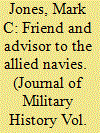

|
|
|
|
|
| Publication |
2013.
|
| Summary/Abstract |
The collaboration during World War II (1939-45) between the British Royal Navy (RN) and the navies-in-exile of Poland, Norway, Netherlands, Belgium, France, Yugoslavia, and Greece necessitated the creation of a liaison system between senior naval officers to ensure the effective integration of Allied navies into RN commands. This article's purpose is to explain the RN's World War II senior-level naval liaison system. It addresses the origin, duties, and evolution of the office of Principal Liaison Officer, Allied Navies (PNLO), and evaluates how the liaison office influenced the relationship between the RN and the Allied navies.
|
|
|
|
|
|
|
|
|
|
|
|
|
|
|
|
| 5 |
ID:
089495
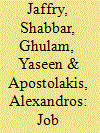

|
|
|
|
|
| Publication |
2009.
|
| Summary/Abstract |
Retention is a crucial issue in the Armed Forces, especially in the all-volunteer Royal Navy. This is mainly due to a number of organisational challenges and changes in operational requirements and priorities. Naval manpower planners need to consider appropriate measures to improve retention in the service. The evidence gathered from the empirical investigation shows that external (pull) factors exert a significant effect on the early exit/quit rates from the RN. Key economic factors such as pay and employment opportunities in the civilian employment markets play an important role in the decisions that individual ratings make with regard to remaining in naval employment or leaving altogether. In particular, it was found that quit rates from the Navy are negatively associated with the claimant count (unemployment) rate (i.e. as the unemployment rate in the civilian economy increases, the early exit rate from the Navy decreases), whilst the overall increase in civilian wages bears a positive relationship on quitting behaviour. The analysis provides further evidence to support the need for policies that are tailor-made to cater for different ratings' specialisations within the Royal Navy.
|
|
|
|
|
|
|
|
|
|
|
|
|
|
|
|
| 6 |
ID:
181967
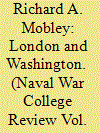

|
|
|
|
|
| Summary/Abstract |
Recently declassified British records reveal London’s misgivings about America’s 1987 reflagging and escorting of Kuwaiti tankers amid the Iran-Iraq War. This early case study illustrates the challenges of conducting coalition warfare in the Middle East, even with a close, cooperative partner. National-level differences revealed surmountable fissures in coordinating naval strategies and operations, yet the benefits of the relationship justified the friction encountered.
|
|
|
|
|
|
|
|
|
|
|
|
|
|
|
|
| 7 |
ID:
116772
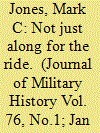

|
|
|
|
|
| Publication |
2012.
|
| Summary/Abstract |
World War II was the testing ground for multinational naval operations, particularly the British Royal Navy's association with the European navies-in-exile from Poland, Norway, the Netherlands, France, Yugoslavia, and Greece. In order for the Allied ships to operate alongside British vessels, it was necessary to place a liaison staff on each foreign ship. This article explains how the liaison system worked, describes what life was like for liaison personnel on a foreign ship, and evaluates the effectiveness of the liaison system. The article is based on documents from the British National Archives and first-person accounts.
|
|
|
|
|
|
|
|
|
|
|
|
|
|
|
|